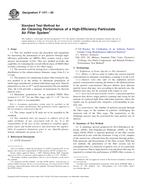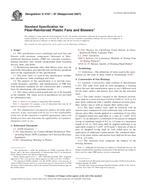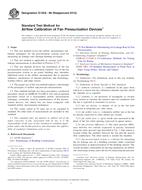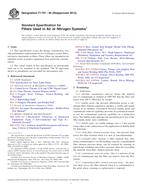Wir benötigen Ihre Einwilligung zur Verwendung der einzelnen Daten, damit Sie unter anderem Informationen zu Ihren Interessen einsehen können. Klicken Sie auf "OK", um Ihre Zustimmung zu erteilen.
ASTM F1471-09
Standard Test Method for Air Cleaning Performance of a High-Efficiency Particulate Air- Filter System (Withdrawn 2018)
Automatische name übersetzung:
Standard Test Method for Air Reinigungsleistung eines High-Efficiency Particulate Air-Filtersystem
NORM herausgegeben am 1.3.2009
Informationen über die Norm:
Bezeichnung normen: ASTM F1471-09
Anmerkung: UNGÜLTIG
Ausgabedatum normen: 1.3.2009
SKU: NS-50415
Zahl der Seiten: 13
Gewicht ca.: 39 g (0.09 Pfund)
Land: Amerikanische technische Norm
Kategorie: Technische Normen ASTM
Kategorie - ähnliche Normen:
Die Annotation des Normtextes ASTM F1471-09 :
Keywords:
aerosol dilution, aerosol generator, average penetration, background particles, challenge aerosols, coincidence, compressed-air nebulizer, dilution ratio, fractional penetration, HEPA, laser aerosol spectrometer, test aerosols, Aerosol dilution, Aerosol generator, Airflow performance, Average penetration, Background particles, Calibration--spectrochemical analysis instrumentation, Challenge aerosols, Coincidence counting, Compressed air, Diluter calibration, Dilution ratio/value
Ergänzende Informationen
| Significance and Use | ||||
|
This test method describes a procedure for determining the penetration of aerosols through a one- or twostage HEPA filter installation. Testing multiple filter stages as a single unit eliminates the need for: installation of auxiliary aerosol bypass ducts, installation of aerosol injection manifolds between filter stages, and entry of test personnel into contaminated areas. It provides for filter testing without interruption of plant processes and operation of ventilation systems. The procedure is applicable for measuring penetrations requiring sensitivities to 0.1 μm. A challenge concentration of 2.5 × 10 5 particles/cm3 (p/cm3), is required for evaluation of one-filter stage, and 2 × 106 p/cm 3, or about 30 μg/L (assuming unit density), is required to properly evaluate a two-stage HEPA filter system as one unit. This test method can determine the penetration of HEPA filters in the particle-size range from 0.1 to 0.2 μm where the greatest penetration of particles is likely to occur. |
||||
| 1. Scope | ||||
|
1.1 This test method covers the procedure and equipment for measuring the penetration of test particles through high-efficiency particulate air (HEPA) filter systems using a laser aerosol spectrometer (LAS). This test method provides the capability of evaluating the overall effectiveness of HEPA filter systems consisting of one or two filter stages. 1.2 The aerosols used for testing have a heterodisperse size distribution in the submicrometer diameter range from 0.1 to 1.0 μm. 1.3 The purpose for conducting in-place filter testing by this test method is in the ability to determine penetration of multi-stage installations, without individual stage tests. Particle penetration as low as 10−8 can be measured by this test method. Also, the LAS provides a measure of penetration for discrete particle sizes. 1.4 Maximum penetration for an installed HEPA filter system is 5 × 10−4 for one filter stage, and 2.5 × 10−7 for two stages in series is recommended. Note 1—Acceptance penetration criteria must be specified in the program, or owners specifications. The penetration criteria suggested in this test method is referenced in Ref (1). 1.5 The values stated in SI units are to be regarded as the standard. 1.6 This standard does not purport to address all of the safety problems, if any, associated with its use. It is the responsibility of the user of this standard to establish appropriate safety and health practices and determine the applicability of regulatory limitations prior to use. Specific precautionary statements are given in 9.6. |
||||
| 2. Referenced Documents | ||||
|
Ähnliche Normen:
Historisch
1.11.2007
Historisch
1.4.2008
Historisch
1.10.2012
Historisch
1.5.2013
Historisch
1.11.2011
Empfehlungen:
Aktualisierung der technischen Normen
Wollen Sie sich sicher sein, dass Sie nur die gültigen technischen Normen verwenden?
Wir bieten Ihnen eine Lösung, die Ihnen eine Monatsübersicht über die Aktualität der von Ihnen angewandten Normen sicher stellt.
Brauchen Sie mehr Informationen? Sehen Sie sich diese Seite an.



 ASTM D4167-97(2007)..
ASTM D4167-97(2007).. ASTM D6830-02(2008)..
ASTM D6830-02(2008).. ASTM E1258-88(2012)..
ASTM E1258-88(2012).. ASTM F1791-00(2013)..
ASTM F1791-00(2013).. ASTM F2105-11
ASTM F2105-11
 Cookies
Cookies
